Metal and Glass Shelf Units: Style and Function
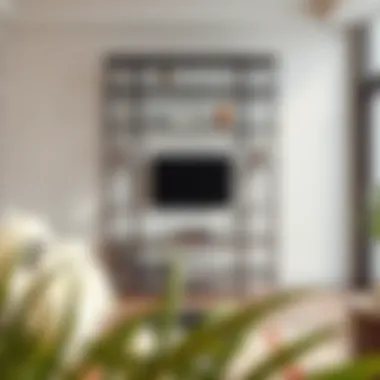
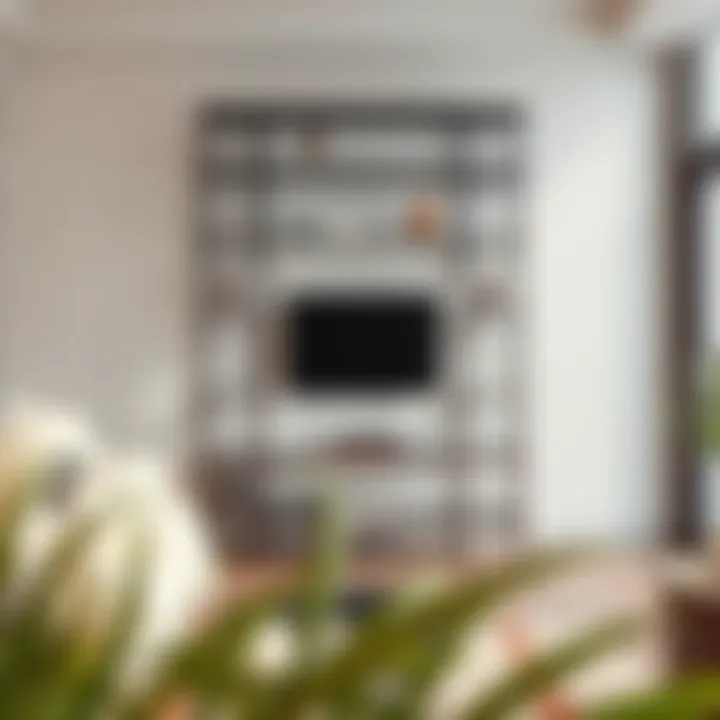
Intro
In a world where clean lines and minimalism reign supreme, metal and glass shelf units have taken their place as both practical storage solutions and eye-catching decor elements. Straddling the line between functionality and aesthetics, these units not only offer display and organization but also adapt beautifully to various interior styles. The blend of sturdy metals with sleek glass creates an enduring appeal that speaks volumes in contemporary design. The intersection of these materials paves the way for a discussion on current trends, their multifunctionality, and of course, maintenance practices that ensure their longevity.
Understanding how metal and glass shelves can fit into your spaces means diving into key features. Homeowners and designers alike are often on the hunt for pieces that are not only useful but also tell a story or make a statement. This article aims to shed light on the evolving styles, functionality, and care associated with these shelf units. From examining modern versus traditional aesthetics to the latest trends in colors and materials, this exploration can help inform your next purchase or DIY project.
Furniture Styles and Trends
Modern vs. Traditional: Understanding the Aesthetics
Metal and glass units showcase a remarkable flexibility, flowing seamlessly between modern and traditional design schemes. Modern designs prioritize simplicity and geometric forms. They often feature exposed metal frames—think blackened steel or brushed aluminum—that allow light to filter through the glass, creating a sense of spaciousness in smaller rooms. These units complement minimalist spaces, making them a favorite in urban lofts and contemporary homes.
In contrast, traditional designs may employ more ornate frameworks, incorporating brass or gold finishes alongside glass shelves that hint at vintage elegance. These units can find their home in classic settings, standing proudly in dining rooms or studies, displaying heirlooms or family photographs. The key is how these shelves blend with the surrounding decor, bridging the past and present in a beautifully cohesive way.
Color and Material Trends: What's In and What's Out
Staying in tune with color and material trends is crucial for anyone looking to enhance their living space. Currently, deep jewel tones like emerald green and sapphire blue are making waves, especially for backend walls where metal shelf units can pop against rich color. Soft, muted pastel shades are also gaining traction, lending a fresh, airy feel to otherwise industrial materials.
Material-wise, glass treatments like frosted finishes are increasingly in vogue, offering a softer appearance and a degree of privacy for items displayed on the shelves. Pairing this with matte black or antique gold metal frames provides a stunning juxtaposition that catches the eye. On the other hand, uncoated metals and transparent glass are waning, with homeowners opting for finishes that add warmth and texture to the coldness of glass.
Furniture Care and Maintenance
Tips for Prolonging the Life of Your Furniture
To maintain the stylish appeal of your metal and glass shelf units, proper care is paramount. Here are some straightforward tips:
- Regular Dusting: Use a soft cloth to dust off shelves weekly to prevent buildup.
- Avoid Harsh Chemicals: Stick to gentle cleaning agents to avoid etching the glass.
- Check for Loose Screws: Periodically inspect metal frames for any loose nails or screws to maintain stability.
- Avoid Overloading: Each shelf has a weight capacity; respect it to prevent sagging or breakage.
DIY Repair Hacks for Common Furniture Issues
In the event of scratches or minor dents, don’t worry! There are simple fixes you can try:
- For glass scratches, a light application of baking soda mixed with water can sometimes minimize visibility.
- Metal frames can often be touched up with a matching paint or finish, ensuring they aren’t an eyesore.
- If you encounter screws that have stripped, consider using wood glue to hold them in place, then replace the screw.
Bolder designs call for bolder care. Ensuring your metal and glass shelf unit remains a focal point of your decor is wholly achievable with routine maintenance and some handy repair skills.
Overall, understanding how to harmonize functionality with aesthetics in metal and glass shelf units can empower both homeowners and designers to create and maintain inviting spaces. With the right attention, these units can serve as more than just storage—they become an integral part of your home's beautiful narrative.
Preface to Metal and Glass Shelf Units
The metal and glass shelf units serve as a bridge between functionality and aesthetics in modern interior design. These versatile furniture pieces not only offer practical storage solutions but also enhance the overall ambiance of any space. As homeowners and designers delve deeper into the art of curating their environments, understanding the value of these shelf units becomes paramount.
Defining the Metal and Glass Shelf Unit
At its core, a metal and glass shelf unit is a hybrid shelving structure that combines the durability of metal with the elegance of glass. Typically, these units feature a framework made of robust metals like steel or aluminum, providing a sturdy base while showcasing glass shelves that allow for light to flow through. This contrast between opaque and transparent materials creates a striking visual effect that can complement various design styles.
Whether utilized in living rooms, kitchens, or offices, these shelf units fulfill practical needs while simultaneously acting as decorative elements. They can be placed against walls, used as room dividers, or even as standalone pieces, adding versatility to their functionality. The range of designs spans minimalist and modern to more ornate and traditional styles, ensuring that there’s a fit for every taste and requirement.
Historical Context and Evolution
The journey of metal and glass shelf units is quite fascinating. Historically, these materials have been utilized in various forms, but it wasn’t until the Industrial Revolution that metal became widely used in furniture making. The introduction of mass production methods made it possible to produce metal frames at scale, leading to an increase in their availability and affordability.
Glass, on the other hand, has a rich heritage that dates back thousands of years. Initially considered a luxury material, advances in technology have made glass more accessible for everyday use. During the mid-20th century, the combination of glass and metal started to gain popularity in design. This era saw the emergence of sleek silhouettes and streamlined forms, as fashion and function began to merge seamlessly.
As design trends evolved into the 21st century, the integration of metal and glass in furniture has seen a significant resurgence. Contemporary designers have embraced these materials not just for their aesthetic appeal, but for their environmental sustainability as well. With increasing awareness of eco-friendly practices, the use of recycled metals and energy-efficient glass production has transformed the market landscape. Thus, metal and glass shelf units are not just functional; they stand at the forefront of modern design thinking.
Materials and Construction
Exploring the metal and glass shelf unit inevitably leads us to the heart of its appeal: the materials and construction techniques that define its durability and style. The combination of metal and glass creates a unique blend that stands out not just in terms of functionality but also in aesthetics. Understanding these materials helps us appreciate how they contribute to both the practical and visual elements of these units.
The Role of Metal in Shelf Design
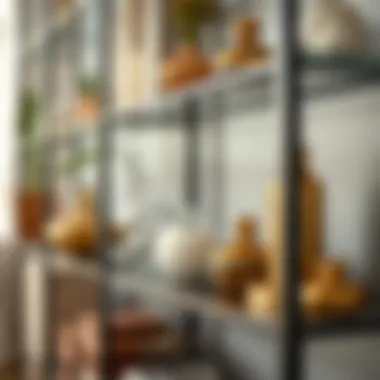
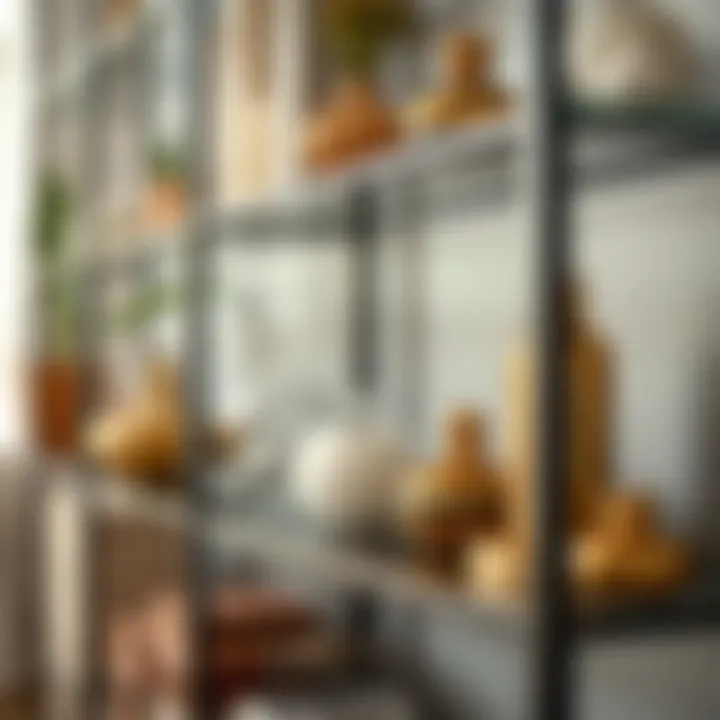
Metal plays a pivotal role in the design of shelf units. Not only does it provide structural support, but it also adds a modern touch. Various metals can be used, including steel, brass, or aluminum, each offering different characteristics that help shape the overall look and feel. For instance, stainless steel is often favored for its strength and resistance to corrosion, making it a practical choice for areas exposed to moisture like kitchens. The finish of the metal can also significantly influence the aesthetic, with a brushed texture giving off a more industrial vibe, while polished surfaces lend a sleek sophistication.
The versatility of metal allows for a myriad of styles, from minimalist frameworks that maximize visibility to more ornate designs that enhance the character of a space. These features can echo the tastes and identities of homeowners, designers, and retailers alike. A well-constructed metal framework can offer stability that is hard to match, ensuring that shelves can hold a significant amount of weight without sagging or bending, thus keeping your favorite decor and books safe.
The Utility of Glass
Glass is another key material that elevates the shelf unit from the ordinary to the extraordinary. Its transparent nature creates an illusion of space, which is particularly beneficial in smaller environments where maximizing the feeling of openness is necessary. Beyond the practical benefits, glass also serves an aesthetic function — it allows light to flow through, showcasing items displayed on the shelves beautifully.
Moreover, glass can come in various types, such as tempered or frosted, allowing homeowners to choose based on desired visibility and safety needs. Tempered glass, for example, is often used because it is more resilient than regular glass; it is less likely to shatter upon impact, making it a wise choice for homes with children or pets.
Regular cleaning is required to maintain glass's clear appearance, but the effort is often well worth it. When combined correctly with metal, glass can become a beautiful focal point in any room.
Combining Metal and Glass: Structural Integrity
The combination of metal and glass in shelf units not only enhances their visual appeal but also reinforces structural integrity. When designed effectively, the metal framework supports the glass shelves securely, allowing for more dynamic shapes and configurations. This duo not only looks striking but is engineered to withstand various loads without compromising stability.
"Combining metal and glass in shelf design allows for a versatile blend of form and function, appealing to both aesthetic preferences and practical needs."
This hybrid approach also opens the door for insightful design innovations, such as adjustable shelving options or integrated lighting features that further enhance usability. Designs that emphasize this combination can adapt to changing interior trends, keeping a space fresh and modern without requiring a complete overhaul. Good craftsmanship ensures that these materials work together harmoniously, maximally utilizing their strengths while minimizing any weaknesses.
Design Aesthetics
In the realm of interior design, aesthetics take center stage, making the appearance of each element crucial. The integration of metal and glass shelf units seamlessly combines form and function, offering not just practical storage but also a flair that resonates with modern living. These shelf units serve as both display pieces and organizers, providing a balance that is visually appealing while maintaining a high level of utility.
Style Variations: Modern, Industrial, and Classic
When it comes to style, metal and glass shelf units come in a plethora of designs to cater to varying tastes.
- Modern designs often feature sleek lines and minimalistic approaches. These units typically use shiny metal frames combined with clear, tempered glass, allowing light to bounce off surfaces and creating an airy feel in any room. Perfect for those who want a fresh, contemporary vibe.
- On the other hand, industrial shelving tends to embrace a rawer aesthetic. Think weathered wood combined with dark, rusted metal. This style harks back to factories and warehouses, infusing spaces with a rugged yet chic charm. Such units work well in lofts or homes where an urban touch is desired.
- Lastly, we have the classic style that may incorporate ornate metalwork and stained glass. These units evoke a sense of tradition and sophistication, suitable for homeowners who appreciate vintage or timeless designs.
Having a range of stylistic options means that there is practically a metal and glass shelf unit for every type of décor, ensuring that aesthetics serve as a bridge between functionality and personal expression.
Color Palettes and Finishes
The color palette and finish of a metal and glass shelf unit can further enhance its aesthetic appeal and functionality. Here, homeowners can play with a spectrum of choices that align with their personal taste and existing decor.
Common finishes include:
- Brushed nickel or chrome for a polished look. This adds a modern twist and reflects light beautifully.
- Matte black or gunmetal grey offers a sophisticated and understated option, while still remaining versatile.
- Rustic iron can add warmth and character, particularly in industrial-themed spaces.
When selecting colors, keep in mind the overall scheme of your room. A soft color palette, perhaps in whites or pastel tones, can create a serene environment with light glass shelves. Meanwhile, bolder finishes can serve as statement pieces, drawing the eye and sparking conversation.
In short, carefully considering the color palettes and finishes allows for aesthetic harmony between the shelf unit and its surroundings, thus enhancing the visual impact of the room.
"The way you choose colors and designs reflects your taste, ultimately shaping how you feel within your own space. "
Functional Applications
When considering the integration of metal and glass shelf units into a living space, understanding their functional applications is critical. These units are not merely decorative; they solve everyday storage and display challenges while also contributing significantly to the aesthetic of the environment. The blend of metal's durability and glass's elegance creates versatile uses across different settings. This section delves into various functional applications, highlighting how these units can fulfill storage needs while also elevating the design of spaces.
Living Room: Display and Storage Solutions
In the heart of most homes, the living room often serves as a gathering place, and the right shelving can enhance that experience through both display and storage options.
- Showcase Personal Style: Metal and glass shelf units provide the perfect platform to display art, books, or collectibles. Their transparent nature allows items to be viewed without overwhelming the space. A collection of vintage vinyl records or handcrafted pottery can transform a simple wall into a statement piece.
- Maximize Functionality: Beyond aesthetics, these shelves are practical. They can hold a television, along with sound systems or decorative items, optimizing the organization of cords and gadgets. Incorporating baskets or boxes on the shelves can hide clutter while keeping it accessible.
Moreover, an important consideration in living rooms is the balance between open space and storage. Metal and glass shelves lend an airy feel, making even a small living room appear larger than it is.
Kitchen: Practical Organization
The kitchen is often referred to as the heart of the home, and having a well-organized kitchen is vital not only for functionality but for enjoyment while cooking or entertaining.
- Efficient Use of Space: Metal and glass shelving units can be tailored to fit any kitchen style, whether modern or rustic. They allow easy access to frequently used spices and utensils while adding a touch of elegance. A glass shelf displaying attractive jars of ingredients can lift up the overall cooking atmosphere.
- Hygienic and Easy to Clean: One significant advantage of glass shelving in the kitchen is its cleanliness. Unlike wood, glass can be wiped down easily, combating stains from splatters or spills. Metal brackets and frames also contribute to this ease, resisting corrosion over time.
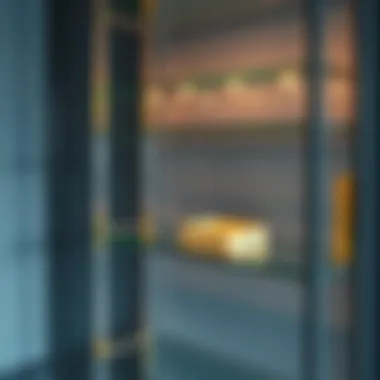
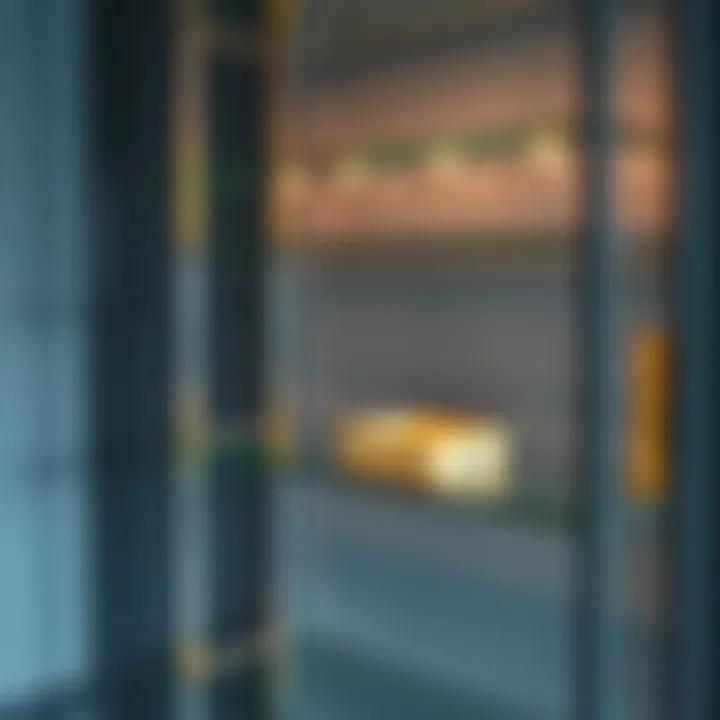
Many contemporary kitchens now feature these units as a design choice, blending utility with style. They're not just shelves; they are part of the culinary decor that makes meal prep more enjoyable.
Office: Enhancing Workspace Efficiency
When it comes to productivity, the layout of an office plays a crucial role. Metal and glass shelves can significantly enhance workspace efficiency.
- Declutter Your Desk: A metal and glass shelf unit positioned above a desk can hold essential items like documents, books, and files within arm’s reach, minimizing the clutter on the desk itself. This leads to better focus and less distraction, promoting a more productive work environment.
- Customization Options: The adaptability of these units allows for customization, whether it’s height adjustment to fit different tasks or varying shapes that can conform to the existing office layout. They can be tailored for small home offices or large corporate setups, always maintaining an air of professionalism.
Using such units in an office context also reflects a modern aesthetic while reinforcing a sleek and organized working environment.
Metal and glass shelf units transcend mere functionality; they serve as an embodiment of style and practicality across various environments.
Integrating these shelving solutions into different spaces transforms everyday functionality into an opportunity for artistic expression.
Installation Considerations
When it comes to integrating metal and glass shelf units into your home, installation is an essential part of the process. It's not just about putting the shelf up on the wall; it's also about ensuring it functions safely and looks aesthetically pleasing. Understanding the nuances of installation can lead to a more effective setup that enhances both the appearance and utility of your living space. Proper installation can prevent future issues, such as sagging or falling shelves, which can cause damage to items placed on them or even pose safety risks.
Assessing Wall Strength and Stability
Before you even think about hanging a metal and glass shelf, it's vital to assess the integrity of your wall. Not all walls are created equal; for instance, drywall alone may not support heavy loads, versus a concrete or brick wall that offers a more solid foundation. Here’s how to properly evaluate your wall:
- Inspect the type of wall: Check if it is drywall, plaster, or brick. Each has different holding capacities.
- Check for studs: Use a stud finder to mark where the studs are located. Anchoring to studs provides the most strength.
- Test for stability: Lightly push on the wall to ensure it feels solid, without any give or movement.
- Weight considerations: Know the total weight of the shelf unit and the items you intend to place on it. For instance, a shelf designed to hold decorative items can afford to be lighter than one intended for books or kitchenware.
Assessing these elements not only helps in selecting the right installation method but also provides peace of mind.
Mounting Methods: Brackets and Anchors
Once you have ensured your wall can handle the load, the next step is selecting appropriate mounting methods. Proper brackets and anchors play a crucial role in the long-term stability of your shelves. Below are common options:
- Wall Brackets: These provide support directly under the shelf and are essential for heavier loads. There are different types of brackets, such as:
- Wall Anchors: If screws are going into drywall without studs, a wall anchor is necessary to prevent the screws from pulling out. Common types include:
- L-brackets: These are commonly used and can support substantial weight.
- Floating brackets: These are invisible once installed, giving a sleek appearance but can require additional installation care.
- Toggle bolts: These are excellent for heavier loads in hollow walls.
- Plastic anchors: Ideal for lighter shelves, but may not be reliable for significant weight.
Remember: Take time to follow the manufacturer’s installation instructions closely to ensure a secure setup. This can make a world of difference in how the shelf functions over time.
Care and Maintenance
Maintaining a metal and glass shelf unit requires attention to detail, ensuring that both aesthetics and durability are preserved. Proper care and maintenance not only prolong their lifespan but also keep them looking sharp and new. This section delves into effective cleaning techniques as well as strategies to mitigate wear and damage over time.
Cleaning Techniques for Metal and Glass
Keeping your metal and glass shelves clean is essential for both visual appeal and practical use. Short, regular cleanings can help prevent dust buildup, fingerprints, and stains. Here are some effective techniques:
- Glass Cleaning: For the glass surfaces, a simple solution of warm water and mild dish soap works wonders. Use a soft microfiber cloth or a sponge to gently wipe the surface, avoiding abrasive materials that might scratch. Rinse with clean water and dry with a lint-free cloth to prevent streaks.
- Metal Maintenance: Metal components can be susceptible to fingerprints and smudges. A damp cloth with a touch of vinegar can help remove stubborn spots. Make sure to dry the metal quickly to prevent moisture from settling. For metal with special coatings, always check the manufacturer's recommendations for cleaning agents.
- Deep Cleaning: Every once in a while, removing all items from the shelves provides a good opportunity for a thorough clean. Take the time to polish metal elements with a suitable metal polish. For glass, consider a glass cleaner if streaks persist after soap and water.
Caution is key: Never use abrasive cleaners on glass or metal finishes to avoid scratches or dulling.
Preventing Damage and Wear
To ensure long-term enjoyment of your metal and glass shelf unit, taking proactive measures in preventing damage is paramount. Here are some vital strategies:
- Avoid Overloading: Each shelf usually comes with a specified weight limit. It’s essential to adhere to these limits to prevent warping or breaking. Overburdened shelves can lead to structural issues.
- Temperature and Humidity Control: Extreme conditions can fast-track wear. When placed too close to heat sources or exposed to high humidity, both metal and glass can suffer. A well-ventilated, consistent environment can significantly help maintain integrity.
- Use Coasters and Liners: When placing items on the glass shelf, using coasters for drinks and protective liners for heavier objects can guard against scratches and water stains. This small step can go a long way in preserving the shelf’s surface.
- Regular Inspections: Make it a habit to inspect your shelf unit at regular intervals. Look out for signs of rust on the metal parts and ensure that glass panels are properly seated in their frames. Addressing minor issues early can prevent more significant problems in the future.
In summary, putting effort into the care and maintenance of your metal and glass shelf unit not only enhances their visual charm but also ensures they stay functional for years to come. By employing simple cleaning methods and taking measures to prevent wear, you'll extend the unit's life while showcasing its beauty.
Sustainability in Metal and Glass Furniture
In recent years, the emphasis on sustainable practices within the home and furniture industry has grown significantly. As individuals become more conscious of their environmental footprints, the selection of materials used in furniture production—like metal and glass—takes center stage. Understanding sustainability in metal and glass shelf units goes beyond mere aesthetics; it dives deep into responsible sourcing, recyclability, and the broader environmental impacts of these materials.
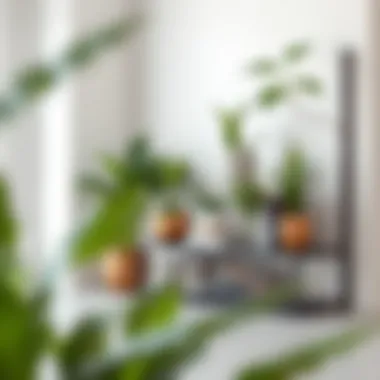
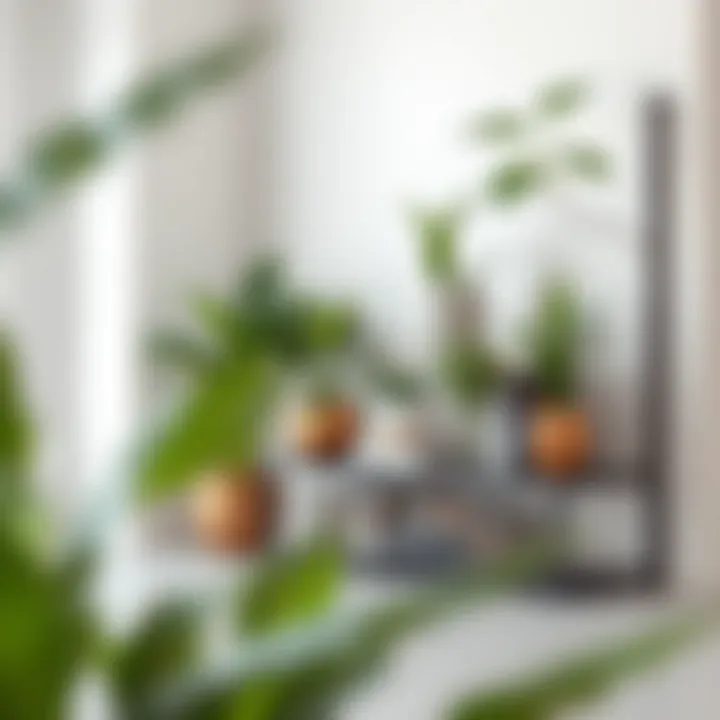
Adopting metal and glass shelf units can bring a dual benefit: they offer a blend of timeless elegance and sustainable functionality. Not only do they contribute to a stylish interior but they also allow users to make eco-conscious choices in their décor. Homeowners and designers alike are increasingly interested in how their furniture impacts the planet. Ultimately, investing in sustainable furniture is not just about incorporating trendy designs; it's about supporting global efforts for a healthier environment.
Recyclability of Materials
One of the most appealing aspects of metal and glass is their recyclability. Metal, for instance, can be melted down and reshaped endlessly without losing its properties. This property ensures that old or damaged metal components can be repurposed into new furniture or other products, minimizing waste.
Similarly, glass can be recycled multiple times. In fact, the process of recycling glass is highly efficient. By reusing this material, it reduces the need for new raw materials, often eliminating the costs and hazards associated with glass production.
- Benefits of recyclability:
- Reduced landfill waste: Recycling keeps metal and glass out of landfills, decreasing environmental pollution.
- Energy savings: The energy required to recycle metal and glass is far less than creating them from virgin materials.
- Supporting sustainable practices: Choosing recyclable materials stimulates recycling industries and encourages responsible production methods.
When someone opts for a metal and glass shelf unit, that person isn’t just making a design choice; they are investing in sustainability.
Eco-friendly Manufacturing Processes
The production of metal and glass furniture also leans towards eco-friendly practices, especially as companies become more aware of their impact on the environment. A significant number of manufacturers have embraced processes that reduce energy consumption and emissions during production.
For example, some metal fabrication techniques, like laser cutting or water jet cutting, generate minimal waste and use significantly less energy compared to traditional methods. On the glass side, utilizing alternative energy sources in manufacturing plants can drastically reduce the carbon footprint.
Many brands are also keen on sourcing materials locally to lower transportation emissions, aligning with the principles of sustainability. Thinking globally but acting locally is a common motto in eco-conscious manufacturing.
The result?
- Efficient resource use.
- Lower greenhouse gas emissions.
- A furniture industry that aligns with the goals of sustainable development.
In summary, supporting metal and glass furniture, especially when it comes from eco-friendly production lines, represents a significant step towards a more sustainable future.
Encouragingly, the trend continues to grow. Homeowners, designers, and retailers collectively champion the cause of sustainability. By choosing well-crafted metal and glass shelf units, they contribute to an eco-friendly movement while enhancing the beauty of their spaces.
Emerging Trends and Innovations
The world of metal and glass shelf units is rapidly evolving, reflecting broader shifts in interior design and consumer preferences. The significance of staying abreast of emerging trends cannot be understated for homeowners, designers, and retailers. These trends not only showcase what is stylish but also what is functional, efficient, and sustainable. Adopting innovative approaches allows spaces to be tailored and enhances the aesthetic while accommodating practical needs. In this final section, we will tackle two prominent trends: the incorporation of smart technology and the flexibility of customizable designs, illustrating how they marry function with contemporary style.
Smart Features and Technology Integration
Smart technology has crept into almost every corner of our lives, and furniture design is no exception. Metal and glass shelf units today are often equipped with features that fuse technology seamlessly into daily life. Features like built-in lighting, smart charging ports, and modular components are becoming increasingly common.
- Integrated Lighting: LED strip lights can be subtly installed within the shelving, casting a warm glow and highlighting decorative items or books. This not only enhances visibility but also creates a mood, allowing homeowners to set the scene in any room.
- Charging Stations: Many modern units are designed with convenience in mind, providing built-in USB ports and wireless charging capabilities. This feature allows for easy access to power without the clutter of additional cords and adapters, keeping spaces tidy and organized.
The integration of technology doesn’t only upgrade these units visually; it also raises their functionality to new heights. Homeowners can easily adapt their shelving systems to fit their lifestyle needs, ensuring that their living areas remain both stylish and practical.
Customizable Designs for Personalized Spaces
Customization is a forefront trend that caters specifically to individual tastes and preferences. Today, metal and glass shelf units are not merely mass-produced items; they can be tailored to suit unique styles, dimensions, and functions.
Homeowners and designers are recognizing the importance of creating spaces that tell a personal story. With options ranging from adjustable shelving heights to unique glass finishes and varying metal tones, flexibility is key. Here are some aspects to consider when thinking about customization:
- Modular Components: Many manufacturers offer modular designs that can be easily reconfigured or expanded. This flexibility allows homeowners to adapt as their needs change over time, making these units a savvy long-term investment.
- Unique Materials and Finishes: From matte black metal frames to frosted glass shelves, the sky’s the limit when it comes to finishing touches. Tailoring these elements ensures that the final product aligns well with existing décor and personal tastes.
- Personal Signage or Inserts: Some designs allow for personal touches, such as custom nameplates or decorative inserts in the glass. This is particularly beneficial for businesses or creative workspaces, allowing them to showcase their identity while still being functional.
By embracing customization, one does not just select a shelf unit; they curate a piece of art that complements their individual space.
As we venture further into a world where individuality is celebrated, embracing these emerging trends offers more than just a trendy unit. It opens doors to creativity, enabling homeowners to craft spaces that reflect their personality and preferences. With smart features and customizable designs, the metal and glass shelf unit is not just a piece of furniture; it’s a pivotal element in modern living.
Ending
The conclusion of this exploration into metal and glass shelf units serves as an essential thread in the fabric of our understanding of modern interior design. It's not just about how these units look; it's about their functionality and the value they bring to a space. As we examined, these shelf units are more than mere decorative pieces; they bridge the gap between utility and aesthetics, bringing forth a blend that suits a variety of styles and purposes.
Recap of Key Insights
To summarize the key points discussed in the previous sections:
- Material Composition: Metal offers strength and durability, while glass contributes an element of elegance and lightness.
- Design Versatility: These units can morph to fit modern, industrial, or classic styles, offering options for nearly every taste.
- Functional Application: From displaying treasured items in the living room to organizing kitchen essentials, their applications are vast and varied.
- Ease of Installation and Maintenance: Knowing how to properly install, as well as maintain, these units ensures their longevity and visual appeal.
- Sustainability Trends: Eco-friendly manufacturing processes and the recyclability of the materials raise the bar for conscious consumers.
"Balancing beauty with practicality is the hallmark of a well-designed shelf unit."
Final Thoughts on Metal and Glass Shelf Units
In the grand scheme of home decor, metal and glass shelf units present an inviting option for homeowners, designers, and DIY enthusiasts alike. As spaces continue evolving in terms of both function and style, these units will undoubtedly play a transformative role. They invite creativity and personalization, allowing individuals to showcase their unique tastes while simultaneously providing organizational solutions that enhance day-to-day living. It's a flexibility that's hard to find elsewhere in furniture design, tempting anyone looking to refresh their environment.















